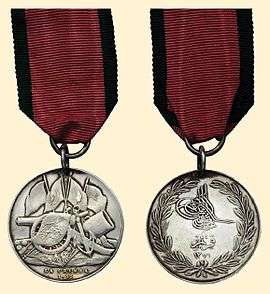Turkish Crimea Medal
| Turkish Crimea Medal | |
|---|---|
 Turkish Crimean War Medal reverse (left) and obverse. Sardinian issue as the flags show. | |
|
Awarded by the | |
| Type | Campaign medal |
| Eligibility | British, French, and Sardinian personnel |
| Campaign(s) | Crimean War |
| Description | Silver disc, 36mm in diameter |
| Statistics | |
| Established | 1856 |
|
Ribbon bar of the medal | |
The Turkish Crimean War Medal (Turkish: Kırım Harbi Madalyası) is a campaign medal issued by Sultan Abdülmecid I of the Ottoman Empire to allied military personnel involved in the Crimean War of 1854–56. It was only awarded to those who survived the war and not to next of kin.[1] There are three different issues of this medal for British, French, or Sardinian personnel.[2] The medal was designed by James Robertson.
British recipients also qualified for the British Crimea Medal.
Design and identification
The obverse shows the Ottoman Sultan’s tughra with the Muslim calendar year of 1271 on all versions.
The reverse depicts a cannon standing upon the Imperial Russian flag, with an anchor and a mortar. The four flags of the allies are to the rear, their order identifying the country for which the medal was intended, either Great Britain, France or Sardinia. The identifying flag is the central right hand flag, positioned above the anchor, the Union Flag for Great Britain, the tricolour for France or the flag of the Kingdom of Sardinia, based on the Italian tricolore. Since Sardinia was ruled at the time by the House of Savoy, this flag has the Savoy shield in the central panel.[3] The Turkish flag is placed centre left on all three versions.[4]
The inscription in the exergue reads "Crimea 1855" for British issue, "La Crimee 1855" for French issue, and "La Crimea 1855" for Sardinian issue.[4]
Due to the loss by shipwreck of many of the medals intended for British recipients, many awards were made with whatever issue came to hand, the most common being of the Sardinian type.[3]
Over the years many have mistakenly believed the flags and cannon to be the obverse of this medal, and many of the recipients wore it that way. The side with the Sultan's cypher or tughra is the correct obverse, although most collectors today continue to mount the medal with the flags and cannon as the obverse.
The general quality of these medals was poor and some British officers had copies of superior quality made in 925 silver with plain or scroll suspenders. These have clearer detail and are generally thicker and heavier; they are often seen in groups mounted by Messrs. Hunt and Roskill. The British versions of this medal are also generally believed to have a slightly higher silver content than the French or Sardinian versions.[4]
Ribbon
The ribbon is watered and of dark crimson with green edges. The original ribbon issued with this medal measured only .5 inches (13 mm) wide (similar to a miniature medal ribbon) and often used two widths, but it was usually replaced by one of 1.25 inches (32 mm) when awarded to British personnel. The medal was originally suspended via two small steel rings, although the one on the medal itself can be silver. Not only did they tend to rust, but these rings were almost universally altered to take the wider ribbon conforming to standard British type. Other suspensions were also used and therefore many medals are found with a privately attached scroll or other suspender akin to British medal types. Such medals are still considered contemporary and the alterations do not alter their value.
Naming
This medal was issued unnamed but examples are found with privately engraved naming of varying styles.

See also
References and further reading
- ↑ Orders and Medals Research Society Journal, Summer 1984, page 100
- ↑ John Mussell (ed). Medal Yearbook 2015. p. 145. Published by Token Publishing Ltd. Honiton, Devon.
- 1 2 Christodoulou, Glenn Medals of the Crimean War - Crimean War Research Society (1985)
- 1 2 3 Joslin, Litherland and Simpkin. British Battles and Medals. p. 134. Published by Spink, London. 1988.
- Joslin, Litherland and Simpkin, British Battles and Medals Published by Spink, London. 1988}}
- David M. Goldfrank, The Origins of the Crimean War
- Winfried Baumbart, The Crimean War, 1853-1856
- Guy Arnold (Editor), John Worronoff (Editor), Historical Dictionary of the Crimean War
- Ulrich Keller, Ultimate Spectacle: A Visual History of the Crimean War
- George Frederick Dallas, Michael Hargreave Mawson (Editor), Eyewitness in the Crimea : The Crimean War Letters of Lt. Col. George Frederick Dallas
External links
- "The King's Own Royal Regiment Museum, (Lancaster), Turkish Crimea Medal". www.kingsownmuseum.plus.com.
- Hayward, John. "Numismatic Notes Part 7: After the War was Over - Turkish Crimea Medal 1856-1862". spink.com. London: Spink. Retrieved 2010-06-15. Detailed account of issue to British forces.